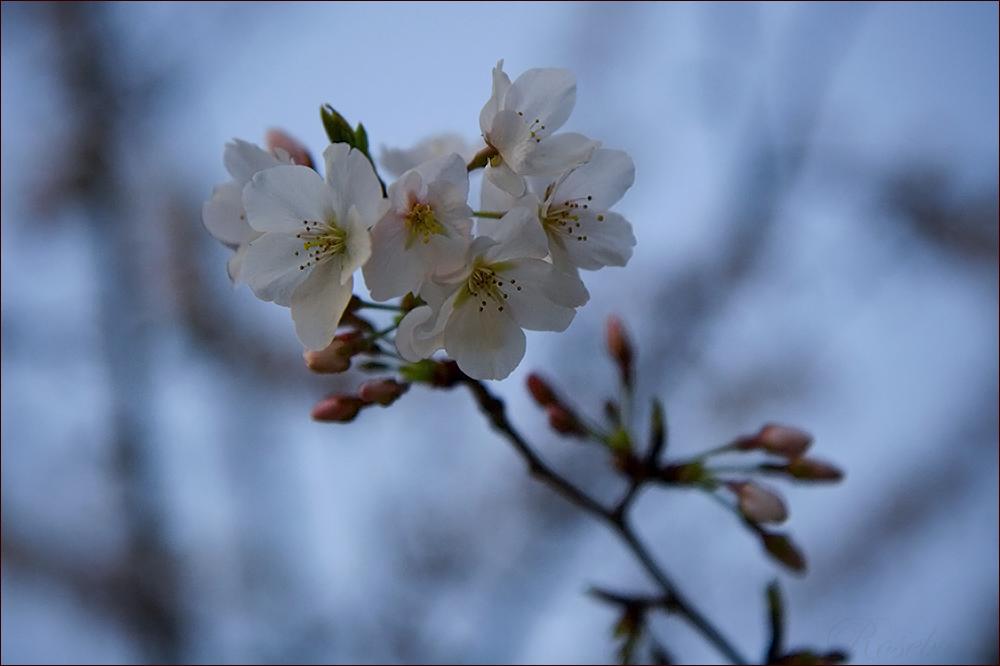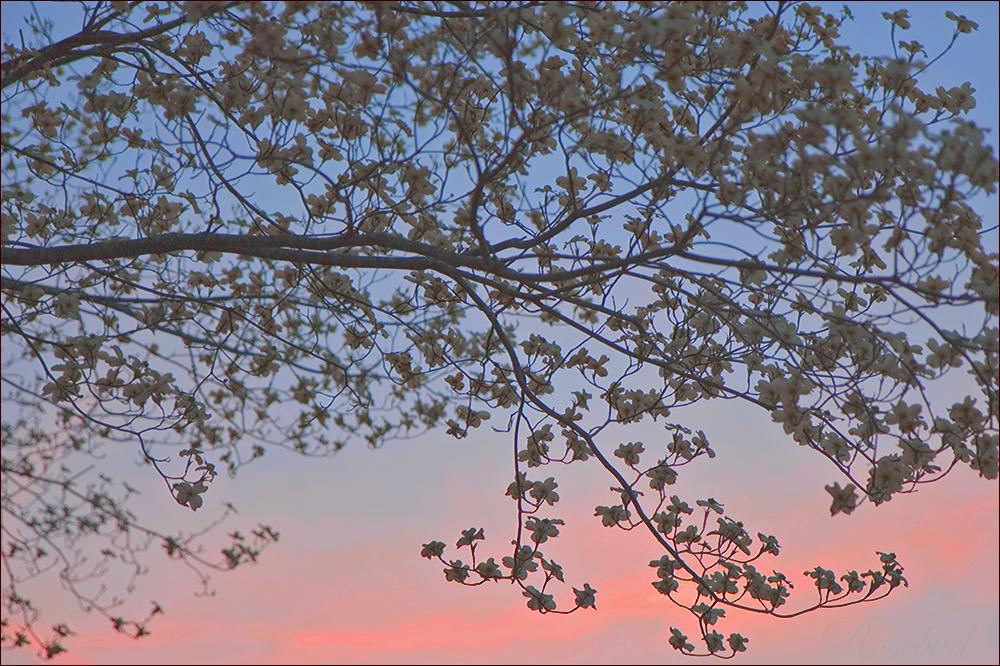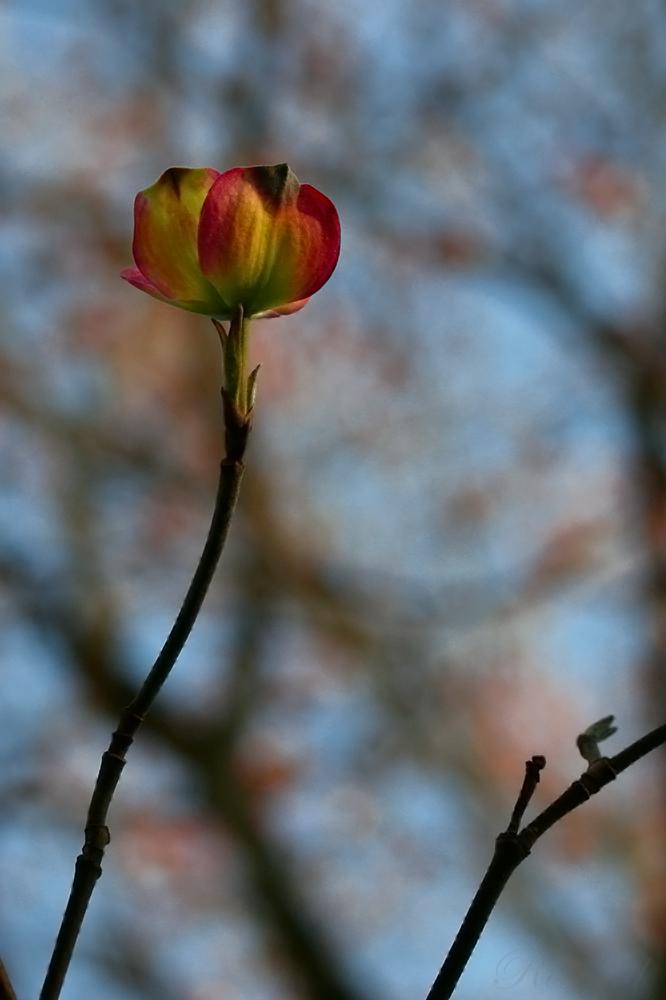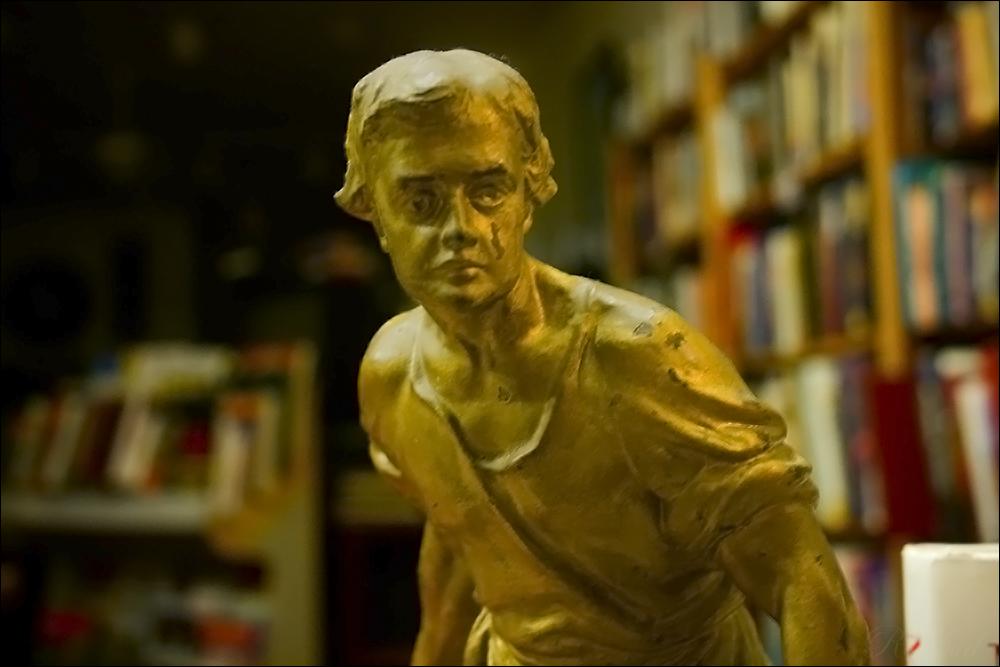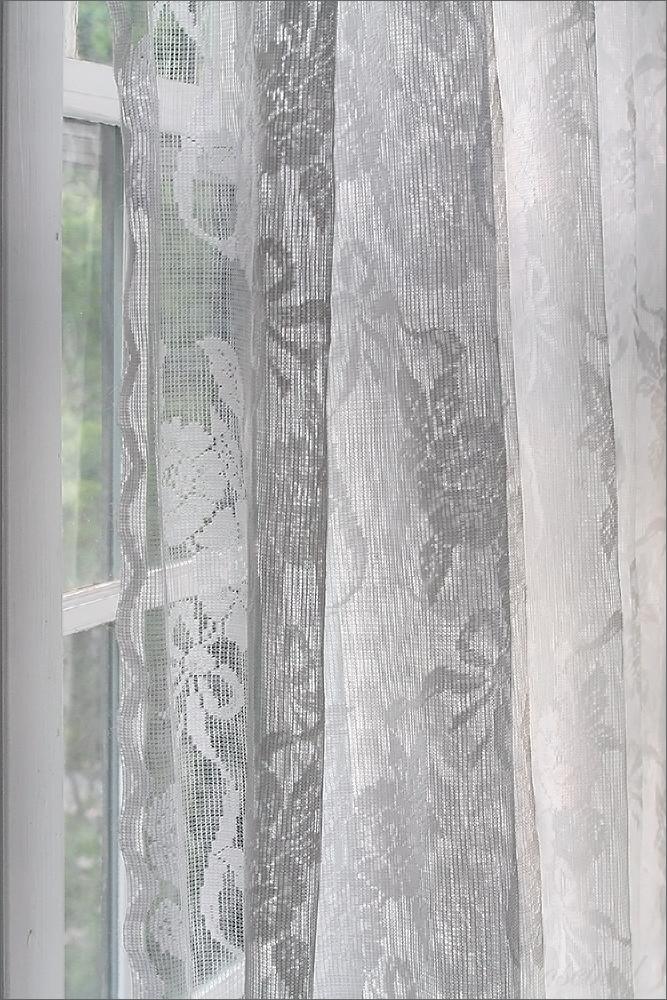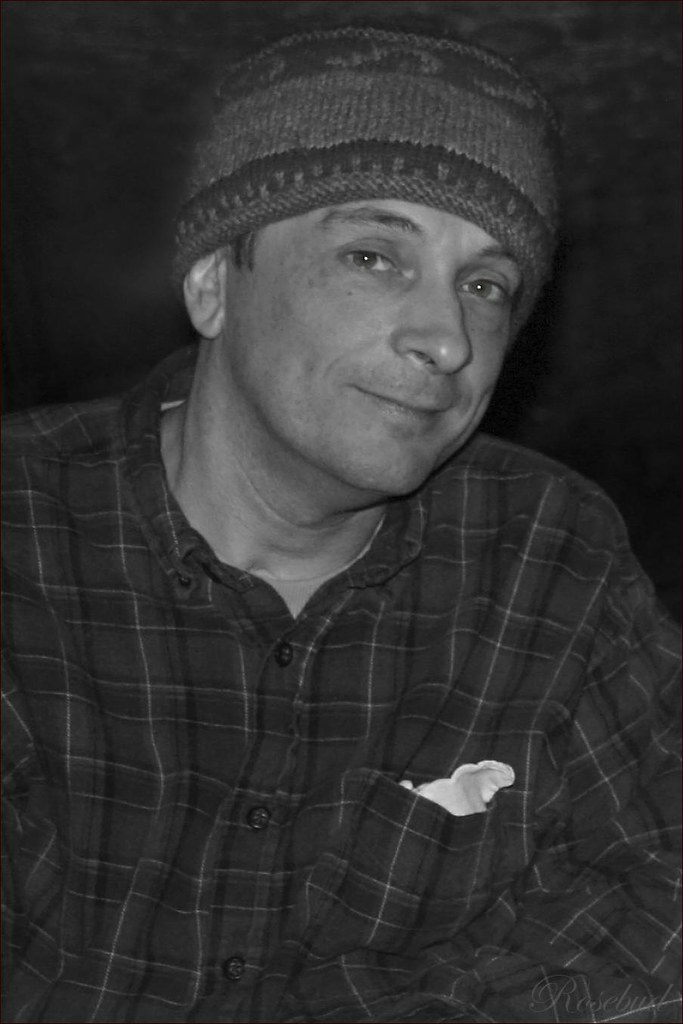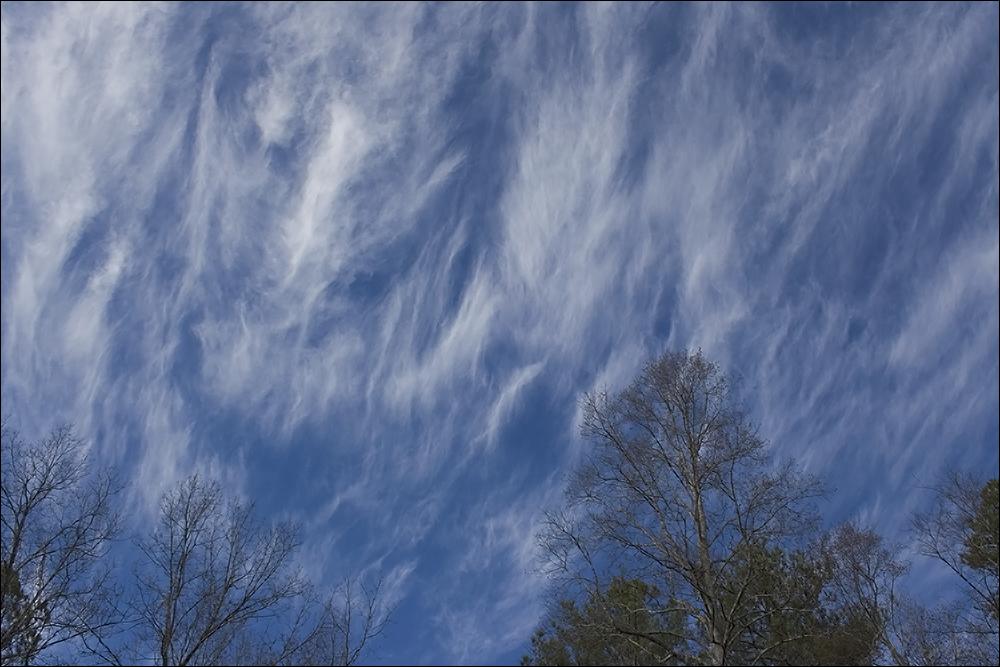Monday, March 31
the capacity to be overwhelmed
The beauty that is human, and the beauty that is made (art)—both raise the fantasy of possession. Our model of the disinterested comes from the beauty of nature—a nature that is distant, overarching, unpossessable.
From a letter written by a German soldier standing guard in the Russian winter in late December 1942:
The most beautiful Christmas I had ever seen, made entirely of disinterested emotion and stripped of all tawdry trimmings. I was all alone beneath an enormous starred sky, and I can remember a tear running down my frozen cheek, a tear neither of pain nor of joy but of emotion created by intense experience.
Unlike beauty, often fragile and impermanent, the capacity to be overwhelmed by the beautiful is astonishingly sturdy and survives amidst the harshest distractions. Even war, even the prospect of certain death, cannot expunge it.
-- Susan Sontag "An Argument About Beauty" At the Same Time
Posted by
rb
at
3/31/2008
![]()
Friday, March 28
the dance
We get still farther away from the fundamental facts about speech when we think of it as something that can be written and read, forgetting that what writing, in our clumsy notations, can represent is only a small part of the spoken sound, where pitch and stress, tempo and rhythm, are almost entirely ignored. But even a writer or reader, unless the words are to fall flat and meaningless, must speak them soundlessly to himself. The written or printed book is only a series of hints, as elliptical as the neumes of Byzantine music, from which the reader thus works out for himself the speech-gestures which alone have the gift of expression.
All the different kinds of language have a relation of this kind to bodily gesture. The art of painting is intimately bound up with the expressiveness of the gestures made by the hand in drawing, and of the imaginary gestures through which a spectator of a painting appreciates its 'tactile values'. Instrumental music has a similar relation to silent movements of the larynx, gestures of the player's hand, and real or imaginary movements, as of dancing, in the audience. Every kind of language is in this way a specialized form of bodily gesture, and in this sense it may be said that the dance is the mother of all languages.
-- R.G. Collingwood The Principles of Art
Posted by
rb
at
3/28/2008
![]()
Thursday, March 27
the play of rope
As retainer of things, rope bestows yet another great gift to a sojourner. Within constancy of change, the knotted rope allows one to keep track of days and moons, miles and immeasurable phenomena of the night sky. If not the invention of rope, the count was preserved by it. Tie a knot for each watering place or each sleep. By the end you know how many stops it takes from Damascus to Jerusalem. Being able to keep a tally is a door to the sacred realm of numbers.
To have a count of numbers means fewer things escape the keep. Unless you know how many sheep, a flock may be slowly devoured by wolves. If the weeks are not tallied, you may miss the propitious time for planting. A new kind of measure is given by numbers, quantity. Important devices follow. A measuring rod is just a knotted rope made rigid. A calendar is its tableau. Fields and highways, lunar eclipses and meteor showers, could now be tracked. The count gives new meaning to the sense of a lawful cosmos. What is lawful can be counted, and all that happens is countable. Thus lawfulness of phenomena is precisely what may be counted on.
The discovery of quantity led to the early sciences of Pythagorus: arithmetic, astronomy, music, and philosophy. Here, the count lies behind the workings of stars, song, and thought. An early flowering of knowledge recognizes the count as mediator between heavenly precision (perfect differentiation of strands) and earthly inexactitude (blurred boundaries, overlap, and tangled threads.) A thing's essence, its number, determines its hidden place in reality. Proper study of number, however, enables one "to disregard the eyes and other senses and go on to being itself in company with truth" (Republic 7.537d). To seize a counting rope leads to liberation from murky appearances...
A weaver's rope holds a strategy. Therein lies its beauty, one strand placed over another and drawn under a third, carefully over and over again. A strategy is a way and a map—what Ariadne hands Theseus before he enters the labyrinth. She offers a ball of thread, a rope, she has woven. The underground maze is a tangle of blind alleys, dead ends, pitfalls, and quagmires. It is the life inside himself that he is to penetrate. At its center lives a monster, the Minotaur, half man, half bull, that demands sacrifices to its grotesque appetite. To succeed is to keep track of his journey. Ariadne's thread is guide to Theseus's heroic quest and midwife to his own birth. It is an example of rope's power to unriddle the self.
To every rope is assigned a length. The length—to which corresponds the life of each thing—has been cut from a single unbroken string, the proto-rope, that comprises the manifest universe. So modern physics, with its "string theory" of reality, concurs with ancient thought. The length of a tree's time is a few score years; a moth's, a few hours. For each being, rope stretches only so far. What happens then, at breath's last breath, turns on an understanding gained during the full length of breathing. Total dissolution, nothingness, or continuation in some form or formlessness—it depends on the fidelity with which one has sought one's place and accepted an infinitude of other places...
The ancients tell that lifelines were prepared by the three Fates, braiders of rope. Clotho spins the flax, Atropos twists it into thread, and with her shears, Lachesis snips it at the measured length. They are tireless and never sleep. Their intelligence, finer than the gods', knows the points of the rope's natural divisions. A vast netting of all things, knotted at the joints, forever guides their hands as they cut rope for each place. The net is an image, a luminous energy. It is Indira's net on which hangs all things, past, present, and future. The net alone survives all transformations wrought by the Fates, since it is a template of roping, not rope itself. The Fates themselves also have a lifeline. Like all else, they cannot outlive their day and function. When all rope has been cut to length and the manifest universe ended, spinning wheel and shears dissolve, and they too return to sleep undisturbed by dreams.
Whether the Fates provide material for tragedy, theirs is (as is tragedy) nonetheless a play. "This play was played eternally before all creatures," Eckhart writes. It is pure because, being playful, it desires to secure no particular end, as does a work. Interwoven elements of freeplay—dream, fantasy, apparition, or mirage—move free from any pragmatic, creaturely design.
-- David Appelbaum Everyday Spirits
Everyday Spirits
Posted by
rb
at
3/27/2008
![]()
Monday, March 24
That Nature is a Heraclitean Fire and of the comfort of the Resurrection
Cloud-puffball, torn tufts, tossed pillows | flaunt forth, then
chevy on an air-
built thoroughfare: heaven-roysterers, in gay-gangs | they throng;
they glitter in marches.
Down roughcast, down dazzling whitewash, | wherever an elm
arches,
Shivelights and shadowtackle in long | lashes lace, lance, and pair.
Delightfully the bright wind boisterous | ropes, wrestles, beats
earth bare
Of yestertempest's creases; in pool and rut peel parches
Squandering ooze to squeezed | dough, crust, dust; stanches,
starches
Squadroned masks and manmarks | treadmire toil there
Footfretted in it. Million-fueled, | nature's bonfire burns on.
But quench her bonniest, dearest | to her, her clearest-selved spark
Man, how fast his firedint, | his mark on mind, is gone!
Both are in an unfathomable, all is in an enormous dark
Drowned. O pity and indig | nation! Manshape, that shone
Sheer off, disseveral, a star, | death blots black out; nor mark
Is any of him at all so stark
But vastness blurs and time | beats level. Enough! the Resur-
rection,
A heart's-clarion! Away grief's gasping, | joyless days, dejection.
Across my foundering deck shone
A beacon, an eternal beam. | Flesh fade, and mortal trash
Fall to the residuary worm; | world's wildfire, leave but ash:
In a flash, at a trumpet crash,
I am all at once what Christ is, | since he was what I am, and
This Jack, joke, poor potsherd, | patch, matchwood, immortal
diamond,
Is immortal diamond.
-- Gerard Manley Hopkins
Project Gutenberg's Poems of Gerard Manley Hopkins
Posted by
rb
at
3/24/2008
![]()
Saturday, March 22
Garden Abstract
The apple on its bough is her desire,—
Shining suspension, mimic of the sun.
The bough has caught her breath up, and her voice,
Dumbly articulate in the slant and rise
Of branch on branch above her, blurs her eyes.
She is prisoner of the tree and its green fingers.
And so she comes to dream herself the tree,
The wind possessing her, weaving her young veins,
Holding her to the sky and its quick blue,
Drowning the fever of her hands in sunlight.
She has no memory, nor fear, nor hope
Beyond the grass and shadows at her feet.
-- Hart Crane
Posted by
rb
at
3/22/2008
![]()
Friday, March 21
Thursday, March 20
In the Fields
Lord, when I look at lovely things which pass,
Under old trees the shadows of young leaves
Dancing to please the wind along the grass,
Or the gold stillness of the August sun on the August sheaves;
Can I believe there is a heavenlier world than this?
And if there is
Will the strange heart of any everlasting thing
Bring me these dreams that take my breath away?
They come at evening with the home-flying rooks and the scent of hay,
Over the fields. They come in Spring.
-- Charlotte Mew
Charlotte Mew
Posted by
rb
at
3/20/2008
![]()
Tuesday, March 18
Friday, March 14
Thursday, March 13
continuum
And what about what was there before?
This is shaped in the new merging, like ancestral smiles, common memories, remembering just how the light stood on the water that time. But it is also something new. Outside, can't you hear it, the traffic, the trees, everything getting nearer. To end up with, inside each other, moving upward like penance. For the continual pilgrimage has not stopped. It is only that you are both moving at the same rate of speed and cannot apprehend the motion.
-- John Ashbery, from "The New Spirit"
Listen to John Ashbery reading an excerpt of "The New Spirit" here (Side Two of The Songs We Know Best)
John Ashbery
Posted by
rb
at
3/13/2008
![]()
Wednesday, March 12
songs, answers, and prayers
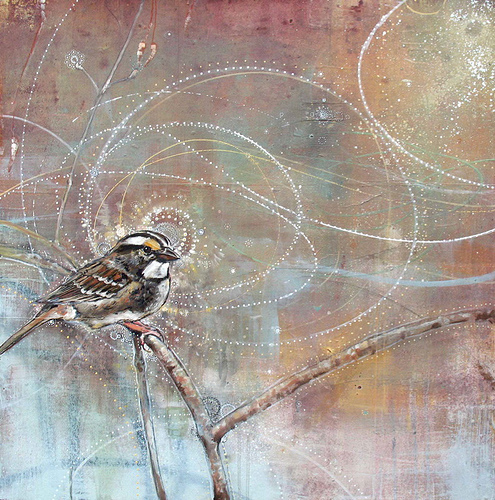
songs, answers, and prayers by David Hale
David Hale Art
flutter installation (bird works by David Hale)
Photo of David at work on a performance painting here
Posted by
rb
at
3/12/2008
![]()
Tuesday, March 11
Of Mere Being
The palm at the end of the mind,
Beyond the last thought, rises
In the bronze distance.
A gold-feathered bird
Sings in the palm, without human meaning,
Without human feeling, a foreign song.
You know then that it is not the reason
That makes us happy or unhappy.
The bird sings. Its feathers shine.
The palm stands on the edge of space.
The wind moves slowly in the branches.
The bird's fire-fangled feathers dangle down.
-- Wallace Stevens
Posted by
rb
at
3/11/2008
![]()
Friday, March 7
the whole and the parts
Nothing exists except in relationship to everything else. Everything exists only in relationship to everything else.
-- Daan Hoekstra "The Artist's Study of Nature and Its Relationship to Goethean Science" Janus Head 10.1
Daan Hoekstra
The Artist's Study of Nature and Its Relationship to Goethean Science (pdf)
Janus Head
Posted by
rb
at
3/07/2008
![]()
Wednesday, March 5
Tuesday, March 4
from translucency to transparency
Chert, flint, agate, and glassy rock can flake to a cutting edge only a few atoms thick. Prehistoric people made long oval knives of this surpassing sharpness, and made them, wittingly, too fragile to use. Some people—Homo sapiens—lived in a sub-freezing open-air camp in central France about eighteen thousand years ago. We call their ambitious culture Solutrean; it lasted only about three thousand years. They invented the bow and arrow, the spear thrower, and the needle—which made clothes such a welcome improvement over draped pelts...
Solutrean artisans knapped astonishing yellow blades in the shape of long, narrow pointed leaves. The longest Solutrean blade is fourteen inches long, four inches at its beam, and only one-quarter inch thick. Most of these blades are the size and thickness of a fillet of sole. Their intricate technique is overshot flaking; it is, according to Douglas Preston, "primarily an intellectual process"...
Hold one of these chert knives to the sky. It passes light. It shines dull, waxy gold—brown in the center, and yellow toward the edges as it clears. At each concoidal fractured edge all the way around the double-ogive form, at each cove in the continental stone, the blade thins from translucency to transparency. You see your skin, and the sky. At its very edge the blade dissolves into the universe at large. It ends imperceptibly at an atom.
Each of these delicate, absurd objects takes hundreds of separate blows to fashion. At each stroke and at each pressure flake, the brittle chert might—and, by the record, very often did—snap. The maker knew he was likely to lose many hours' breath-holding work at a tap. The maker worked in extreme cold. He knew no one would ever use the virtuoso blades. He protected them, and his descendants saved them intact, for their perfection. To any human on earth, the sight of one of them means: someone thought of making, and made, this difficult, impossible, beautiful thing.
-- Annie Dillard For the Time Being
Posted by
rb
at
3/04/2008
![]()
Monday, March 3
panoramas of shifting energy: the sky, the ocean
Nico Muhly: "It Goes Without Saying" from Speaks Volumes, created in Reykjavík and New York City (read liner notes)
He paints the sky with his work. The melody and notes are almost invisible, and he thinks in terms of these panoramas of shifting energy, which at their best are so beautiful.
-- Antony Hegarty of Antony and the Johnsons, on the composer Nico Muhly, quoted by Rebecca Mead in "Eerily Composed: Nico Muhly's sonic magic" at The New Yorker
The piece began with the melancholy song of the electric violin—looped, three-note phrases overlapping, but never precisely matching up, to create disordered sonic patterns, like uncharted stars. Gradually, other instruments joined in, strings and woodwinds picking up the violin’s three-note signature to form clear constellations of sound. As the momentum built, the entire orchestra was shaped into harmony by the resonant, otherworldly violin. Toward the concerto’s conclusion, the violin engaged in a duet with the celesta—an instrument named for its heavenly sound, and much favored by Muhly—while the other instruments faded out, as if vanishing into a lightening sky. [more]
-- Rebecca Mead, on Nico Muhly's "Seeing is Believing" violin concerto, in "Eerily Composed"
New Yorker Audio: Nico Muhly (includes a live recording of "Seeing is Believing")
The dramatic layering of the opera, paradoxically, requires Britten to consolidate his musical gestures into a few simple ideas that need to expand, like gas, to fit the space they inhabit. Grimes's motives and themes are like little individual drops of water that, when you zoom in, become as complicated and churning as the ocean. After the death of Peter's apprentice, we have another drone piece: the Moonlight Sea Interlude, which obsesses over an E-flat in the violas and French horns, a creamy, unctuous swell. The whole piece is notated a beat away from where you think it should be, a trick of the shadows. Little shimmers of light arrive in the form of a harp and two flutes, and other instruments gather around these focal points, in a series of basic arpeggios. There is barely a tune, barely an idea, except for the swell and the pitch obsessions; starting with the insanely rapturous climax, there is an E-flat held constantly in one instrument or another for about three minutes, even when the harmonies desperately rub against it. [more]
--Nico Muhly, writing on Benjamin Britten's Peter Grimes, in "A Friendly Face in the Crowd" via The Metropolitan Opera
Alex Ross on Aldeburgh, setting of Britten's Peter Grimes (with audio)
Nico Muhly website
Posted by
rb
at
3/03/2008
![]()
